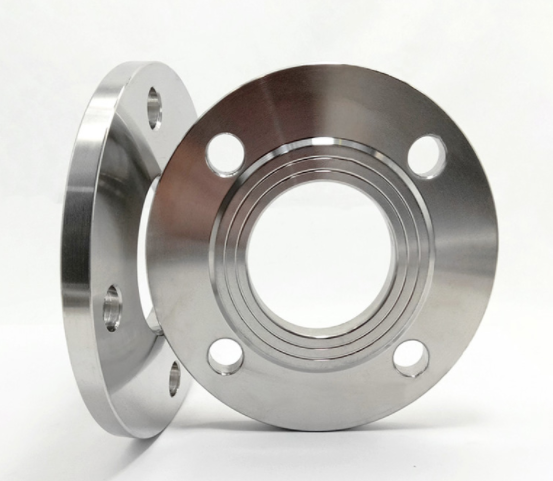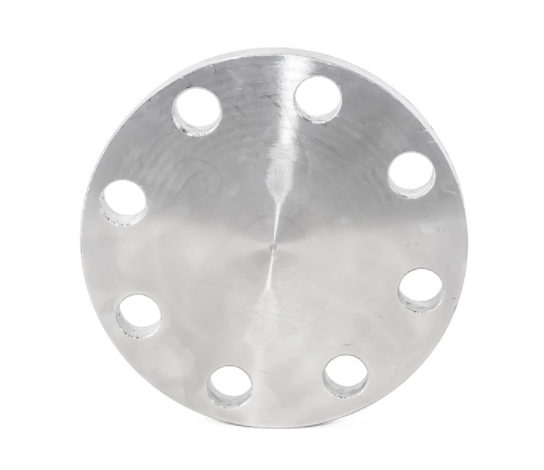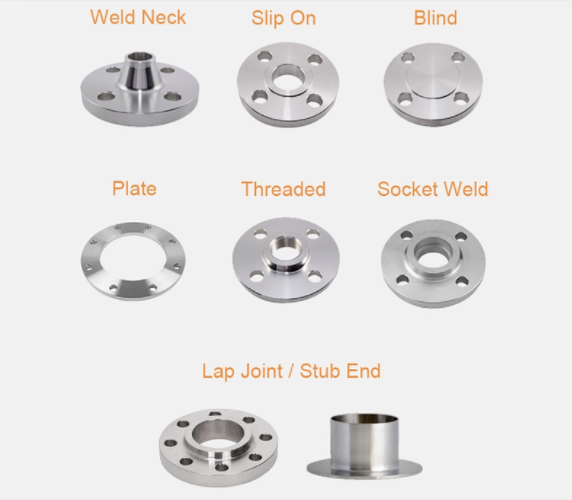We have introduced the common types of flanges in our previous articles, and you should already know them. Today PIPEFUN will talk about the different types of flange faces, including flat, convex, male and female, etc. Read on to learn more about their characteristics.
In the same plane, Flat Face flanges have a gasket surface as the face of the bolted connection circle. Applications using flat face flanges are usually castings made from matching flanges or flange fittings. Flat face flanges are cited as flanges machined to a flat surface and without ridged raised faces or ring joint flanges. Loose flange flats allow complete contact between the gasket and the entire matted surface.
Flat flanges should never be bolted to an elevated flange.ASME B31.1 states that when connecting a flat cast iron flange to a carbon steel flange, the elevated face on the carbon steel flange must be removed and a full end gasket is required. This ensures complete and equal contact between the two mating flanges.

Steel Flat Flange Plate Flange PL RF Face PN16
Convex flanges are the most common type used in fabrication plant applications and are easily identified. It is called raised face because the gasket surface is higher than the bolt ring surface. For all forged steel flanges such as machinery and valves, this form of flange face shield is commonly used. A variety of gasket design combinations can be used for raised face flanges. These combinations can also include flat ring pieces and spiral wound and double jacketed types of metal parts.
Convex flanges are used to concentrate more pressure in a smaller area of the gasket, thereby improving the pressure suppression of the joint. Bolt holes are located in the outer ring area of these flanges. The "shift" adjustment between the two ring heights helps to apply more force to the gasket area, resulting in a stronger seal when the gasket is attached and the bolt is installed and tightened.
Ring joint flanges have grooves to cut steel ring gaskets into their surfaces. When the bent bolt pushes the gasket between the flanges into the groove, the flange closes (or presses together) the gasket and creates a tight contact in the groove, creating a metal-to-metal bond. Typically annular fitting flanges are used in extreme pressure and high temperature systems above 427°C.
The R-type with octagonal sections is the most common RTJ gasket and guarantees a very strong seal. However, the "simple groove" style recognizes both RTJ gaskets with octagonal or oval sections.

ANSI b16.5 1500# Steel BL Flanges RJ connection
Groove and Tongue flanges must fit both Tongue and Groove ears. One side of the flange has a raised ring (tongue) machined into the face of the flange, and the mating flange has a corresponding recess (groove) machined into its nose. Both large and small tongue and groove finishes are standardized. These vary by male and female, as the tongue and groove ID does not extend into the bottom of the flange, thus keeping the gasket on its ID and OD. These are commonly found on valve covers and pump covers.
Tongue and groove joints also have a benefit because they are self-aligning and act as resilient buffers. Slant joints keep the loading point in line with the joint and do not require an intensive machining process.
A male and female flange is a type of flange that is intended to fit into each other. One of these variants has a flange face that extends beyond the usual flange face. This flange is named The Man. the mating flange on the other side or the other flange will have a similar depression machined in its nose. This mating flange is called a female flange
The flange must also be aligned with this table. Each face flange has an area that extends beyond the normal face of the flange (external threads). The other flange or mating flange has a corresponding depression machined into its face (female thread).
The male and female flanges have improved sealing capabilities, more reliable positioning and specific compression of the sealing material using other more effective sealing materials and advanced sealing materials (O-rings).

Carbon Steel - ASTM A105, ASTM A350 LF1/2, ASTM A181
Alloy Steel: - ASTM A182F1 /F2 /F5 /F7 /F9 /F11 /F12 /F22
Stainless steel: - ASTM A182F6 /F304 /F304L /F316 /F316L/ F321/F347/F348
Duplex steel: S31803 / S32205
Super duplex steel: S32750 S32760
Titanium grade: 1 /2 /3 /4 /5 /7
High Nickel Alloy: - Monel ASTM / ASME SB 564 400 /K500
Inconel: 600 /601 /625 /800 /825 /718
Hastelloy: C4 /C22 /B2 /B3
Nickel 200/201
Copper-nickel: 70/30, 90/10, 95/5
Inconel 625 Flange
PIPEFUN is a specialized enterprise professional in producing steel pipes and pipe fittings. Choosing us to be your business partner can bring you great advantages in business! We will talk about international standard of the materials later, and if you want to buy flanges here, please contact our experts and we are happy to serve you.
Copyright © Hebei Pipefun Pipe and Fitting Facility Co., Ltd. All Rights Reserved | Sitemap